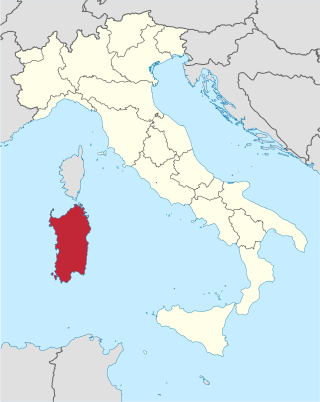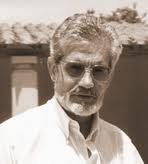
Grazia Maria Cosima Damiana Deledda was an Italian writer who received the Nobel Prize for Literature in 1926 "for her idealistically inspired writings which with plastic clarity picture the life on her native island [i.e. Sardinia] and with depth and sympathy deal with human problems in general". She was the first Italian woman to receive the prize, and only the second woman in general after Selma Lagerlöf was awarded hers in 1909.

Sardinian or Sard is a Romance language spoken by the Sardinians on the Western Mediterranean island of Sardinia.

Sardinia is the second-largest island in the Mediterranean Sea, after Sicily, and one of the twenty regions of Italy. It is located west of the Italian Peninsula, north of Tunisia and 16.45 km south of the French island of Corsica.

Sassarese is an Italo-Dalmatian language and transitional variety between Sardinian and Corsican. It is regarded as a Corso–Sardinian language because of Sassari's historic ties with Tuscany and geographical proximity to Corsica. Despite the robust Sardinian influences, it still keeps its Corsican roots, which closely relate it to Gallurese; the latter is linguistically considered a Corsican dialect despite its geographical location, although this claim is a matter of controversy. It has several similarities to the Italian language, and in particular to the old Italian dialects from Tuscany.
Sardinia is probably the most culturally distinct of all the regions in Italy and, musically, is best known for the tenore polyphonic singing, sacred chants called gosos, the launeddas, an ancient instrument that consists of a set of three single-reed pipes, all three mouth-blown simultaneously using circular breathing, with two chanters and one drone and the cantu a chiterra, a monodic song that is accompanied by guitar, widespread mainly in the center and north of the island.

Maria Carta was a Sardinian folk music singer-songwriter. She also performed in film and theatre. In 1975 she wrote a book of poetry, Canto rituale.

Independence Republic of Sardinia is a regionalist, Sardinian nationalist, left-wing nationalist, social-democratic and non-violent separatist political party in Sardinia. The party, whose long-time leader has been Gavino Sale, supports the establishment of a "Republic of Sardinia" and its independence from Italy.
Gerolamo Araolla, also known as Hieronimu Araolla, was a Sardinian poet and priest.

The Sardinians, or Sards, are a Romance language-speaking ethnic group native to Sardinia, from which the western Mediterranean island and autonomous region of Italy derives its name.
A mutu is a type of improvised sung poetry found in Sardinia. These are traditionally sung mostly by women in response to the male. This type of improvisation called battorinas.

Sardinian nationalism or also Sardism is a social, cultural and political movement in Sardinia calling for the self-determination of the Sardinian people in a context of national devolution, further autonomy in Italy, or even outright independence from the latter. It also promotes the protection of the island's environment and the preservation of its cultural heritage.

Giulio Angioni was an Italian writer and anthropologist.

The literature of Sardinia is the literary production of Sardinian authors, as well as the literary production generally referring to Sardinia as an argument, written in various languages.
Sardinian Literary Spring is a definition of the whole body of the literature produced in Sardinia from around the 1980s onwards.
Marquis of Neoneli is a title granted in 1774 by Victor Amadeus III of Savoy, king of Sardinia, to Sardinian nobleman Pedro Ripoll. It has passed afterwards to the house Sanjust.

Hampsicora was a Sardo-Punic political leader and landowner of Sardinia, and the leader of the major anti-Roman revolt in the province of 215 BC.
The gosos or goccius (Sardinian) or goigs (Catalan) are a kind of devotional and paraliturgical songs sang pertaining to the folk tradition that are dedicated to the Virgin Mary, Jesus Christ, or a saint. They are typical of the Catalan Countries and Sardinia, and written in the Catalan, Sardinian or Spanish languages. They are sung during religious ceremonies, processions, pilgrimages and the votive festivals.

The chiterra sarda or chitarra sarda in Italian, is a large-bodied baritone guitar from Sardinia used primarily to accompany singers in the cantu a chiterra genre. The body is larger than a dreadnought guitar with a scale length of about 680mm. In Italian, it also goes by the names chitarrone and chitarra gigante, both referring to its large size.
Spazio Ilisso - Art Archives Museum is a Sardinian cultural promotion and enhancement center that integrates a museum with a permanent exhibition on 20th century and contemporary Sardinian sculpture, temporary exhibitions, digital archives and events.
Francesco Cesare Casula is a Sardinian historian from Italy.











